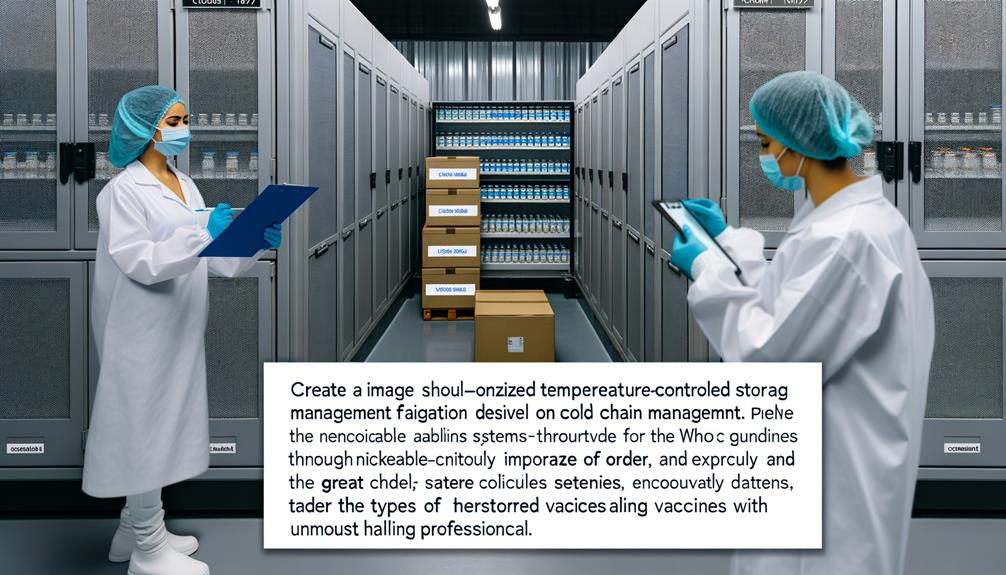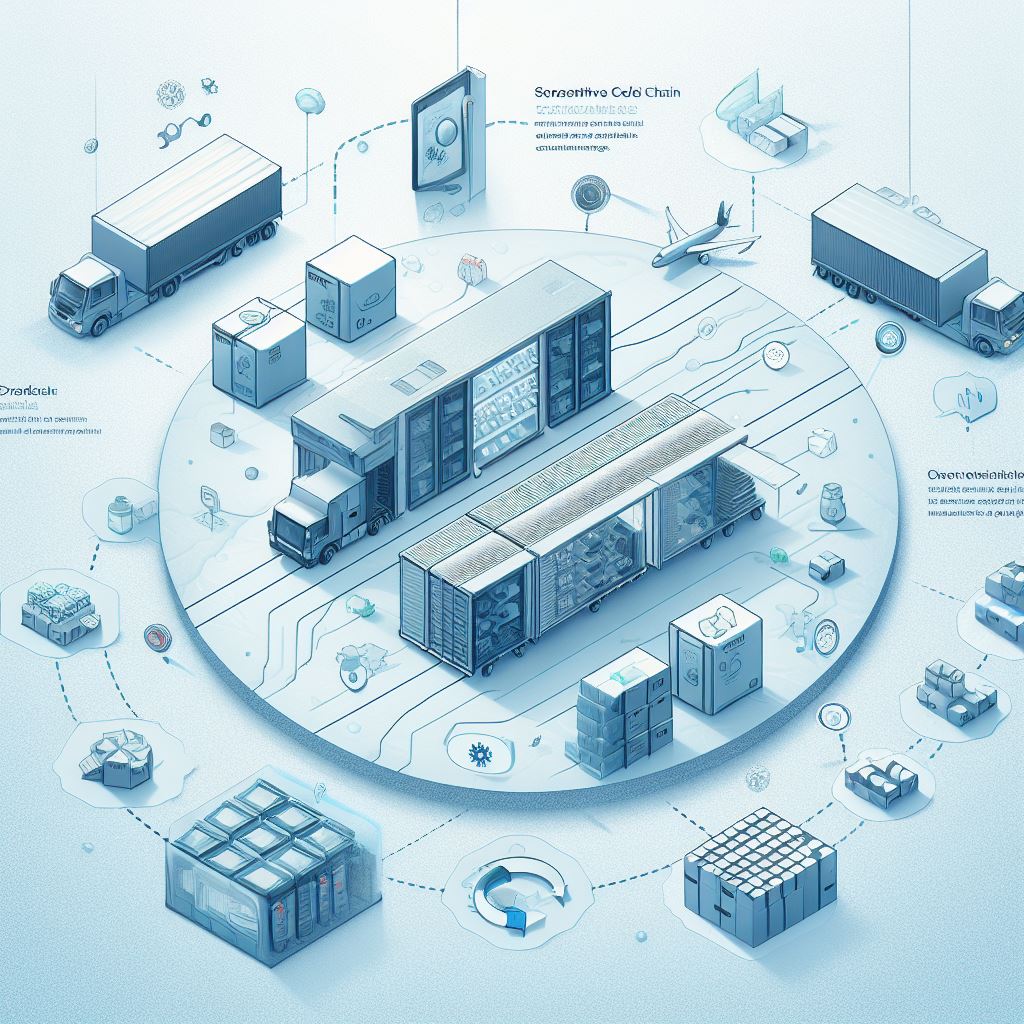Have you ever wondered how global standards on cold chain management can impact the efficacy and safety of vaccines and other temperature-sensitive medical products?
The World Health Organization (WHO) has released comprehensive guidelines to address this critical aspect of healthcare delivery.
As you navigate through the complexities of cold chain management, it’s essential to understand the nuances of WHO’s recommendations and their implications for ensuring the quality and integrity of life-saving vaccines and medications.
Importance of Cold Chain Management
Understanding the critical importance of cold chain management is essential for ensuring the quality and safety of temperature-sensitive products. When you maintain proper temperature controls throughout the entire supply chain, you prevent the degradation of vaccines, pharmaceuticals, and perishable foods. This directly impacts the efficacy of vaccines and medications, as well as the freshness and safety of food products. By adhering to cold chain management protocols, you safeguard against potential health risks associated with consuming compromised products, ultimately protecting the well-being of consumers.
Without effective cold chain management, you risk significant financial losses due to product spoilage. When temperature-sensitive items are exposed to fluctuating or extreme temperatures, their shelf life diminishes rapidly, leading to wasted resources and financial setbacks. Embracing cold chain management practices not only safeguards the integrity of products but also preserves the investments made in acquiring and producing these items.
Additionally, proper cold chain management is crucial for upholding regulatory compliance. Adhering to cold chain guidelines ensures that your operations meet the stringent requirements set forth by regulatory bodies, mitigating the risk of non-compliance penalties and legal repercussions.
Ultimately, embracing the significance of cold chain management is vital for maintaining product quality, consumer safety, financial stability, and regulatory adherence.
WHO Guidelines Overview
To ensure the adherence to cold chain management protocols, it’s essential to understand the WHO guidelines overview for maintaining the quality and safety of temperature-sensitive products. The World Health Organization (WHO) has established comprehensive guidelines to ensure the integrity of the cold chain and the preservation of vaccines, pharmaceuticals, and other temperature-sensitive products.
Here’s an overview of the WHO guidelines:
- Key Principles
- Emphasize the importance of maintaining the cold chain from production to consumption.
- Provide specific temperature ranges and storage conditions for different types of products.
- Implementation Strategies
- Offer recommendations for monitoring and recording temperature data throughout the cold chain.
- Outline best practices for training personnel and handling cold chain equipment.
Understanding these guidelines is crucial for all stakeholders involved in the storage, transportation, and distribution of temperature-sensitive products. By adhering to the WHO guidelines, you can ensure the quality and efficacy of these products, ultimately contributing to the global effort to improve public health and well-being.
Temperature Monitoring and Control
Maintain strict temperature control throughout the cold chain to ensure the quality and efficacy of temperature-sensitive products. Monitoring and controlling temperatures at each stage of the cold chain is crucial for preserving the integrity of vaccines, pharmaceuticals, and other temperature-sensitive products.
Utilize temperature monitoring devices such as data loggers and digital thermometers to continuously track and record temperatures. Place temperature-sensitive products in refrigerators or freezers equipped with temperature alarms and backup power sources to ensure consistent and reliable storage conditions. Regularly calibrate temperature monitoring equipment to maintain accuracy and reliability.
Train personnel on proper temperature monitoring and control procedures to minimize the risk of temperature excursions. Implement standard operating procedures for responding to temperature deviations, including documentation and investigation of root causes.
Cold Chain Equipment and Infrastructure
Ensure that your cold chain equipment and infrastructure are properly maintained and calibrated to uphold the integrity of temperature-sensitive products. Regular maintenance and calibration are crucial to ensure the reliability of your cold chain system. Here are some key points to consider:
- Regular Maintenance:
- Schedule routine maintenance checks for all cold chain equipment, including refrigeration units, freezers, and temperature monitoring devices.
- Conduct thorough inspections for any signs of wear and tear, and promptly address any issues to prevent equipment failure.
- Calibration:
- Implement a regular calibration schedule for temperature monitoring devices to guarantee accurate readings.
- Ensure that calibration procedures comply with international standards and best practices to maintain the accuracy of temperature-sensitive product storage.
Vaccine Storage and Handling
Properly storing and handling vaccines is essential to maintain their efficacy and prevent spoilage.
When receiving vaccine shipments, inspect the temperature-monitoring devices to ensure they haven’t been activated during transit, which could indicate potential temperature excursions.
Immediately place vaccines in the appropriate storage unit, ensuring they’re organized to allow for proper air circulation.
Regularly monitor and record storage unit temperatures, ideally using digital data loggers, and take immediate action if temperatures fall outside the recommended range.
Additionally, be mindful of vaccine expiration dates and prioritize the use of vaccines with the earliest expiration dates to minimize wastage.
When transporting vaccines, use insulated containers with temperature-monitoring devices and ice packs to maintain the required temperature range.
Ensure that vaccines aren’t exposed to direct sunlight or extreme temperatures during transportation.
Lastly, handle vaccines with care to avoid physical damage or exposure to light, as these factors can also affect vaccine potency.
Following these guidelines will help maintain the integrity of vaccines and ensure their effectiveness when administered.
Cold Chain Logistics and Transportation
When transporting vaccines as part of the cold chain logistics, it’s crucial to use insulated containers equipped with temperature-monitoring devices and ice packs to uphold the required temperature range. These containers help maintain the integrity of the vaccines throughout the transportation process, ensuring their efficacy upon arrival at their destination.
Additionally, it’s important to consider the following points:
- Proper Handling: Ensure that vaccines are securely packed within the insulated containers to prevent movement and potential temperature fluctuations during transit.
- Secure Packaging: Use appropriate cushioning materials to keep the vaccines stable and minimize the risk of damage during transportation.
- Monitoring and Compliance: Regularly monitor the temperature of the containers during transit and ensure compliance with the recommended storage conditions.
- Temperature Monitoring: Utilize temperature-monitoring devices to track and record the temperature inside the containers throughout the transportation process.
Quality Assurance and Compliance
As you maintain the integrity of vaccines during transportation, ensuring compliance with recommended storage conditions becomes crucial for quality assurance. Quality assurance in cold chain management involves adhering to industry standards and regulations to guarantee that vaccines remain potent and effective until they reach their intended recipients.
This includes meticulous monitoring of temperature, humidity, and storage duration at each stage of the cold chain. Compliance with these standards not only safeguards the efficacy of the vaccines but also helps prevent wastage and ensures the safety of the administered doses.
It’s imperative to implement robust quality control measures, such as regular equipment maintenance, temperature mapping, and staff training, to uphold compliance with cold chain guidelines. Additionally, maintaining thorough documentation and conducting regular audits are essential components of quality assurance and compliance.
Training and Capacity Building
To ensure the effective management of the cold chain, prioritize ongoing training and capacity building for all personnel involved in the storage and transportation of vaccines. Regular training programs are essential to keep personnel updated on the latest cold chain management practices and technologies. It’s vital to provide comprehensive training that covers handling procedures, equipment maintenance, and emergency protocols.
Additionally, capacity building initiatives should focus on developing leadership and decision-making skills to handle unexpected challenges in the cold chain process.
Training and Capacity Building
- Regular Training Programs
- Cover handling procedures, equipment maintenance, and emergency protocols.
- Capacity Building Initiatives
- Develop leadership and decision-making skills for handling unexpected challenges.
Frequently Asked Questions
What Are the Specific Challenges and Best Practices for Cold Chain Management in Low-Resource Settings?
In low-resource settings, specific challenges for cold chain management include limited infrastructure and resources. Best practices involve using innovative solutions like solar-powered refrigeration and community engagement to ensure vaccine potency and effectiveness.
How Does the WHO Recommend Addressing Cultural and Logistical Barriers to Cold Chain Management in Different Regions?
To address cultural and logistical barriers to cold chain management in different regions, the WHO recommends engaging local communities, adapting technology, and establishing strong supply chains. This approach helps ensure effective vaccine distribution and storage.
What Are the Potential Implications of Not Following WHO Guidelines for Cold Chain Management on a Global Scale?
Not following WHO guidelines for cold chain management on a global scale can lead to compromised vaccine efficacy, increased risk of vaccine-preventable diseases, and financial losses. It’s crucial to adhere to these guidelines for global health protection.
How Does the WHO Recommend Addressing Potential Disruptions in the Cold Chain, Such as Power Outages or Transportation Delays?
Address potential disruptions in the cold chain, like power outages or transportation delays, by implementing backup power sources, monitoring equipment, and establishing contingency plans for alternative transportation routes. WHO recommends proactive measures to maintain cold chain integrity.
What Are the Long-Term Implications of Inadequate Cold Chain Management on Vaccine Efficacy and Public Health Outcomes?
Inadequate cold chain management can compromise vaccine efficacy and public health outcomes in the long term. Without proper storage and transportation, vaccines may lose potency, leading to reduced protection against diseases and potential outbreaks.
Conclusion
In conclusion, navigating global standards for cold chain management is crucial for ensuring the quality and effectiveness of vaccines and other temperature-sensitive medical products.
By following the WHO guidelines on temperature monitoring, equipment and infrastructure, storage, logistics, and quality assurance, you can help maintain the integrity of the cold chain and ultimately protect the health of individuals around the world.
Stay informed, stay compliant, and make a difference in global health.



